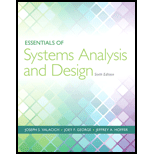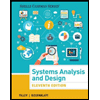
Essentials of Systems Analysis and Design (6th Edition)
6th Edition
ISBN: 9780133546231
Author: Joseph Valacich, Joey George
Publisher: PEARSON
expand_more
expand_more
format_list_bulleted
Expert Solution & Answer
Chapter 1, Problem 17M
Program Description Answer
The term constraint refers to a limit to what a system can achieve.
Hence, correct answer is “Constraint”.
Expert Solution & Answer
Want to see the full answer?
Check out a sample textbook solution
Students have asked these similar questions
8.4 Self-Bias Configuration
20. Determine Zi. Zo. and A,, for the network of Fig. 8.73 if gf, = 3000 μS and gos = 50 μs.
21. Determine Z, Zo, and A, for the network of Fig. 8.73 if the 20-uF capacitor is removed and the
parameters of the network are the same as in Problem 20. Compare results with those of
Problem 20.
+12 V
3.3 ΚΩ
HE
C₂
Vo
Z
Zo
C₁
10 ΜΩ
Z₁
1.1 ΚΩ
Cs 20 µF
FIG. 8.73
Problems 20, 21, 22, and 59.
21. Determine Zi, Zo, and A, for the network of Fig. 8.73 if the 20-μF capacitor is removed and the
parameters of the network are the same as in Problem 20. Compare results with those of
Problem 20.
+12 V
3.3 ΚΩ
+6
C₂
C₁
Z₁
10 ΜΩ
1.1 ΚΩ
Cs
20 μF
FIG. 8.73
Zo
Ninth Edition
Determine Zi, Zo and Av
20 V
Zi
+
1 ΜΩ
2 ΚΩ
HH
Z
IDSS= 6MA
Vp=-6V
Yos = 40μS
20 and 47
Chapter 1 Solutions
Essentials of Systems Analysis and Design (6th Edition)
Ch. 1 - Prob. 1MCh. 1 - Prob. 2MCh. 1 - Prob. 3MCh. 1 - Prob. 4MCh. 1 - Prob. 5MCh. 1 - Prob. 6MCh. 1 - Prob. 7MCh. 1 - Prob. 8MCh. 1 - Prob. 9MCh. 1 - Prob. 10M
Ch. 1 - Prob. 11MCh. 1 - Prob. 12MCh. 1 - Prob. 13MCh. 1 - Prob. 14MCh. 1 - Prob. 15MCh. 1 - Prob. 16MCh. 1 - Prob. 17MCh. 1 - Prob. 18MCh. 1 - Prob. 19MCh. 1 - Prob. 20MCh. 1 - Prob. 21MCh. 1 - Prob. 22MCh. 1 - Prob. 23MCh. 1 - Prob. 24MCh. 1 - Prob. 25MCh. 1 - Match each of the key terms above with the...Ch. 1 - Prob. 27MCh. 1 - Prob. 28MCh. 1 - Prob. 1RQCh. 1 - Prob. 2RQCh. 1 - Prob. 3RQCh. 1 - Prob. 4RQCh. 1 - Prob. 5RQCh. 1 - Prob. 6RQCh. 1 - Prob. 7RQCh. 1 - Prob. 8RQCh. 1 - Prob. 9RQCh. 1 - Prob. 10RQCh. 1 - Prob. 11PECh. 1 - Prob. 12PECh. 1 - Prob. 13PECh. 1 - Prob. 14PECh. 1 - Prob. 15PECh. 1 - Prob. 16PECh. 1 - Prob. 17PECh. 1 - Prob. 18PECh. 1 - Prob. 19PECh. 1 - Prob. 20PECh. 1 - Prob. 21DQCh. 1 - Prob. 22DQCh. 1 - Prob. 23DQCh. 1 - Prob. 24DQCh. 1 - Prob. 25CPCh. 1 - Prob. 26CPCh. 1 - Prob. 27CP
Knowledge Booster
Similar questions
- What is the worst case time complexity of the following algorithm for i = 1 to x do for j = 2^((i-1)x) to 2^(in) do print(i,j)arrow_forwardProve for each pair of expression f(n) and g(n) whether f(n) is big O, little o Ω,ω or Θ of g(n). For each case it is possible that more than one of these conditions is satisfied:1. f(n) =log(n2^n), g(n) = log(sqrt(n)2^(n^2))2. f(n) =nsqrt(n) +log(n^n), g(n) =n + sqrt(n)lognarrow_forwardI need to make a parallel version of this sequential codearrow_forward
- I need to make a parallel version of this sequential code.arrow_forwardBenefits of using arrays as instance variables: What are the advantages of incorporating arrays as instance variables within a class? Initializing and managing arrays: How do you initialize and manage arrays within class constructors and mutators (setters)? Example of using arrays as instance variables: Share an example where you have used arrays as instance variables and discuss its application in a real-world scenario. Common mistakes with arrays as instance variables: What are some common mistakes to avoid when working with arrays as instance variables? Information hiding violations: What is the potential violation of information hiding when using arrays as instance variables? How can this be resolved?arrow_forwardDo you think that computers should replace teachers? Give three references with your answer.arrow_forward
- Is online learning or face to face learning better to teach students around the around the world? Give reasons for your answer and provide two references with your response. What are benefits of both online learning and face to face learning ? Give two references with your answer. How does online learning and face to face learning affects students around the world? Give two references with your answer.arrow_forwardExplain Five reasons if computers should replace teachers. Provide three references with your answer. List three advantages and three disadvantages face to face learning and online learning may have on children. Provide two references with your answer.arrow_forwardYou were requested to design IP addresses for the following network using the address block 10.10.10.0/24. Specify an address and net mask for each network and router interfacearrow_forward
- For the following network, propose routing tables in each of the routers R1 to R5arrow_forwardFor the following network, propose routing tables in each of the routers R1 to R5arrow_forwardUsing R language. Here is the information link. http://www.cnachtsheim-text.csom.umn.edu/Kutner/Chapter%20%206%20Data%20Sets/CH06PR18.txtarrow_forward
arrow_back_ios
SEE MORE QUESTIONS
arrow_forward_ios
Recommended textbooks for you
 Principles of Information Systems (MindTap Course...Computer ScienceISBN:9781285867168Author:Ralph Stair, George ReynoldsPublisher:Cengage Learning
Principles of Information Systems (MindTap Course...Computer ScienceISBN:9781285867168Author:Ralph Stair, George ReynoldsPublisher:Cengage Learning Principles of Information Systems (MindTap Course...Computer ScienceISBN:9781305971776Author:Ralph Stair, George ReynoldsPublisher:Cengage Learning
Principles of Information Systems (MindTap Course...Computer ScienceISBN:9781305971776Author:Ralph Stair, George ReynoldsPublisher:Cengage Learning Fundamentals of Information SystemsComputer ScienceISBN:9781305082168Author:Ralph Stair, George ReynoldsPublisher:Cengage Learning
Fundamentals of Information SystemsComputer ScienceISBN:9781305082168Author:Ralph Stair, George ReynoldsPublisher:Cengage Learning Fundamentals of Information SystemsComputer ScienceISBN:9781337097536Author:Ralph Stair, George ReynoldsPublisher:Cengage Learning
Fundamentals of Information SystemsComputer ScienceISBN:9781337097536Author:Ralph Stair, George ReynoldsPublisher:Cengage Learning Systems ArchitectureComputer ScienceISBN:9781305080195Author:Stephen D. BurdPublisher:Cengage Learning
Systems ArchitectureComputer ScienceISBN:9781305080195Author:Stephen D. BurdPublisher:Cengage Learning Systems Analysis and Design (Shelly Cashman Serie...Computer ScienceISBN:9781305494602Author:Scott Tilley, Harry J. RosenblattPublisher:Cengage Learning
Systems Analysis and Design (Shelly Cashman Serie...Computer ScienceISBN:9781305494602Author:Scott Tilley, Harry J. RosenblattPublisher:Cengage Learning

Principles of Information Systems (MindTap Course...
Computer Science
ISBN:9781285867168
Author:Ralph Stair, George Reynolds
Publisher:Cengage Learning

Principles of Information Systems (MindTap Course...
Computer Science
ISBN:9781305971776
Author:Ralph Stair, George Reynolds
Publisher:Cengage Learning

Fundamentals of Information Systems
Computer Science
ISBN:9781305082168
Author:Ralph Stair, George Reynolds
Publisher:Cengage Learning

Fundamentals of Information Systems
Computer Science
ISBN:9781337097536
Author:Ralph Stair, George Reynolds
Publisher:Cengage Learning

Systems Architecture
Computer Science
ISBN:9781305080195
Author:Stephen D. Burd
Publisher:Cengage Learning

Systems Analysis and Design (Shelly Cashman Serie...
Computer Science
ISBN:9781305494602
Author:Scott Tilley, Harry J. Rosenblatt
Publisher:Cengage Learning